Menus
- Harley-Davidson Road King Classic versus Moto Guzzi California 1400 Touring
- A lot of driving pleasure with both cruisers
- The handlebars of the Italo bike are more relaxed
- Data and measured values Moto Guzzi
- Harley-Davidson data and measurements
- The technology of the bolides
- MOTORCYCLE conclusion
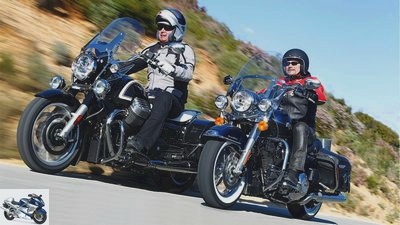
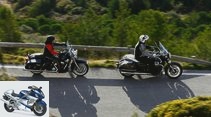
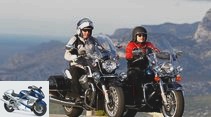
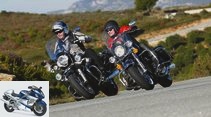
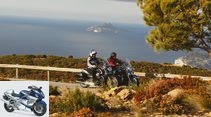
50 photos

1/50
Moto Guzzi California 1400 Touring
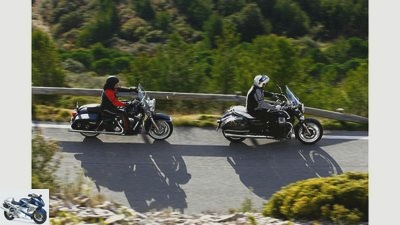
2/50
Harley-Davidson Road King Classic versus Moto Guzzi California 1400 Touring in comparison.
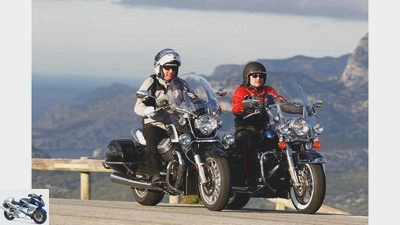
3/50
Harley-Davidson Road King Classic versus Moto Guzzi California 1400 Touring in comparison.
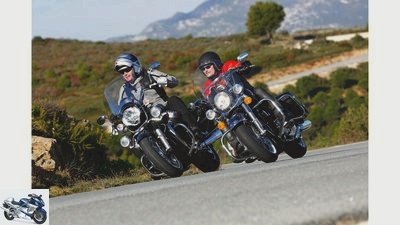
4/50
Harley-Davidson Road King Classic versus Moto Guzzi California 1400 Touring in comparison.
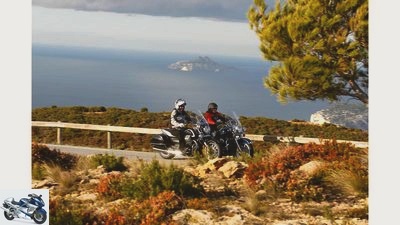
5/50
Harley-Davidson Road King Classic versus Moto Guzzi California 1400 Touring in comparison.
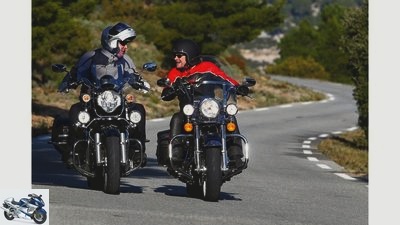
6/50
Harley-Davidson Road King Classic versus Moto Guzzi California 1400 Touring in comparison.
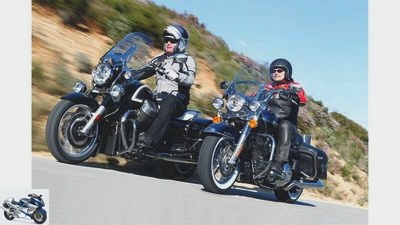
7/50
Harley-Davidson Road King Classic versus Moto Guzzi California 1400 Touring in comparison.
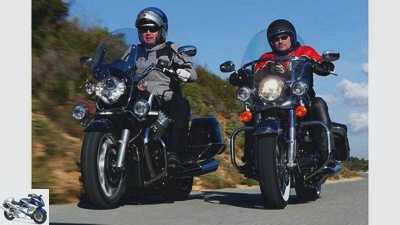
8/50
Harley-Davidson Road King Classic versus Moto Guzzi California 1400 Touring in comparison.
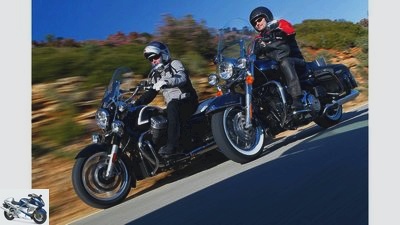
9/50
Harley-Davidson Road King Classic versus Moto Guzzi California 1400 Touring in comparison.
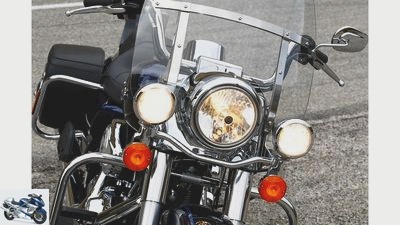
10/50
Harley-Davidson Road King Classic
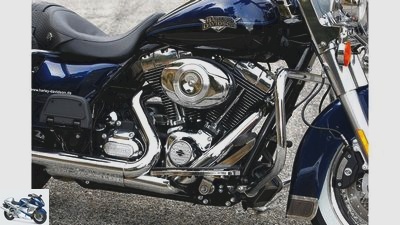
11/50
Harley-Davidson Road King Classic
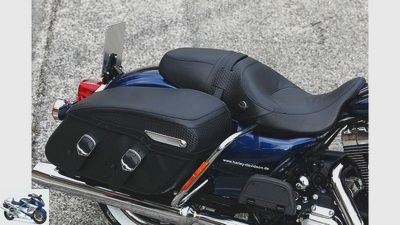
12/50
Harley-Davidson Road King Classic
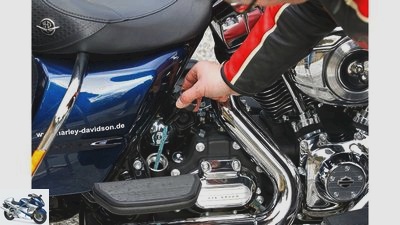
13/50
Harley-Davidson Road King Classic
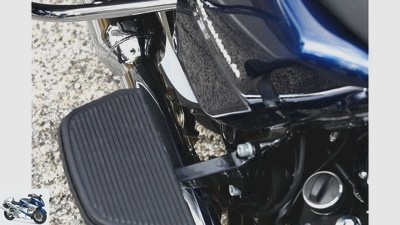
14/50
Harley-Davidson Road King Classic
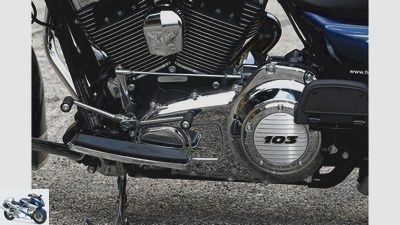
15/50
Harley-Davidson Road King Classic
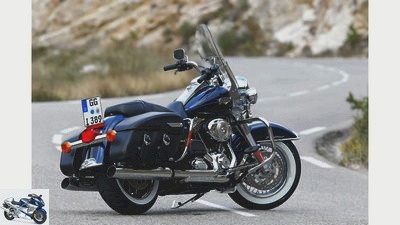
16/50
Harley-Davidson Road King Classic
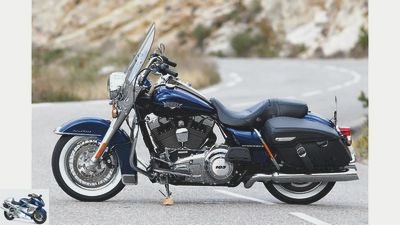
17/50
Harley-Davidson Road King Classic
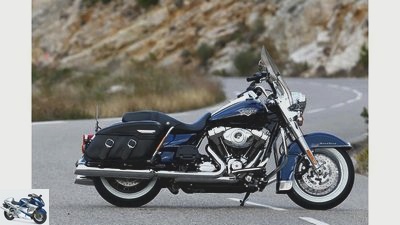
18/50
Harley-Davidson Road King Classic
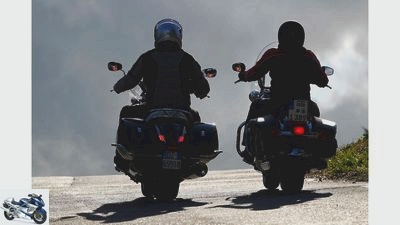
19/50
Harley-Davidson Road King Classic versus Moto Guzzi California 1400 Touring in comparison.
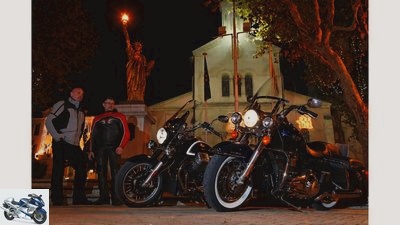
20/50
Harley-Davidson Road King Classic versus Moto Guzzi California 1400 Touring in comparison.
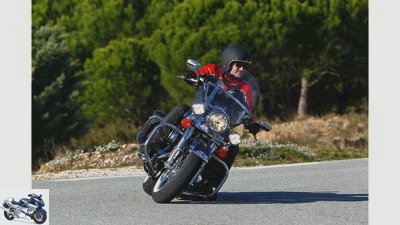
21/50
Harley-Davidson Road King Classic
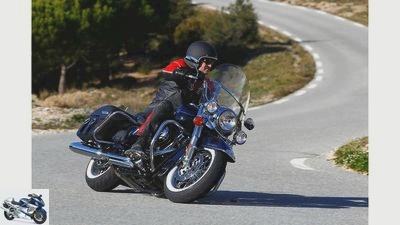
22/50
Harley-Davidson Road King Classic
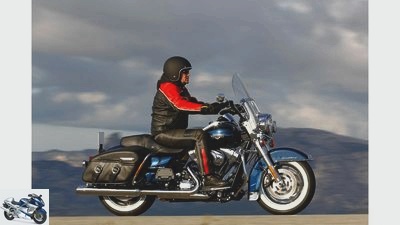
23/50
Harley-Davidson Road King Classic
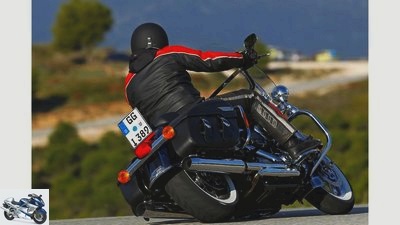
24/50
Harley-Davidson Road King Classic
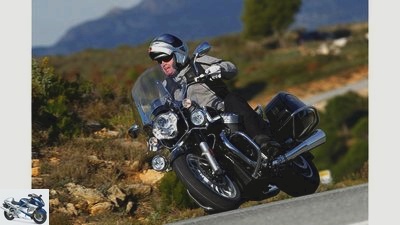
25/50
Moto Guzzi California 1400 Touring
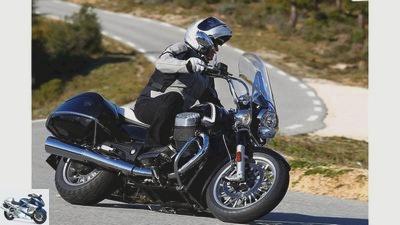
26/50
Moto Guzzi California 1400 Touring
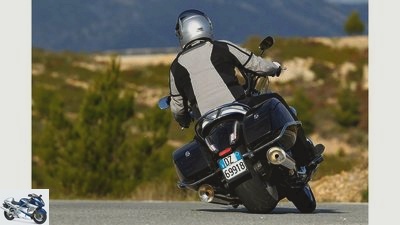
27/50
Moto Guzzi California 1400 Touring
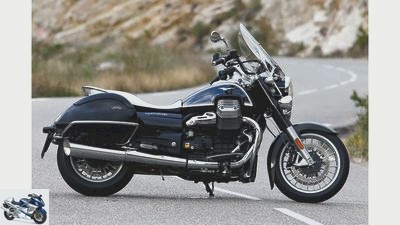
28/50
Moto Guzzi California 1400 Touring
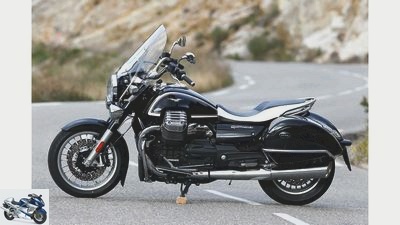
29/50
Moto Guzzi California 1400 Touring
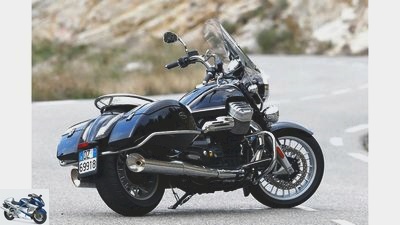
30/50
Moto Guzzi California 1400 Touring
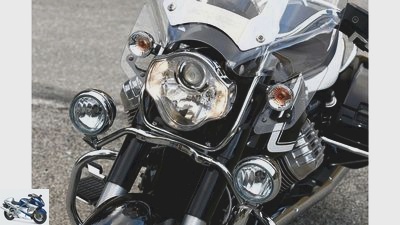
31/50
Moto Guzzi California 1400 Touring
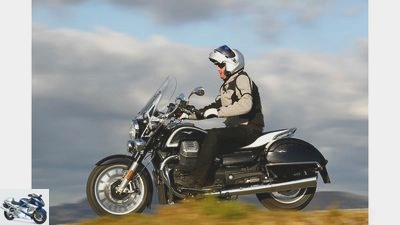
32/50
Moto Guzzi California 1400 Touring
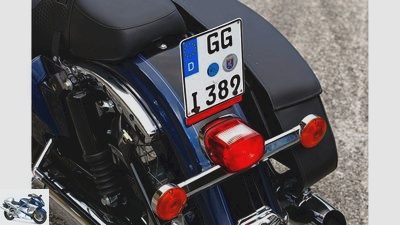
33/50
Harley-Davidson Road King Classic
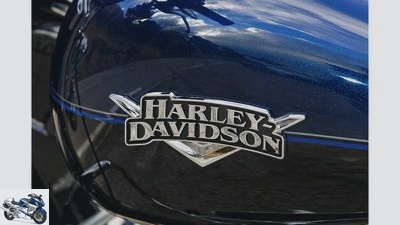
34/50
Harley-Davidson Road King Classic
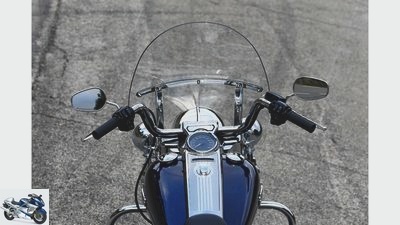
35/50
Harley-Davidson Road King Classic
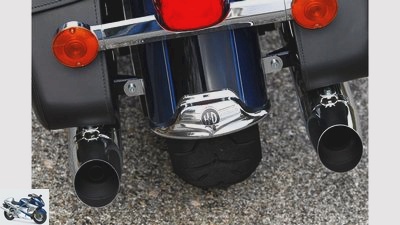
36/50
Harley-Davidson Road King Classic
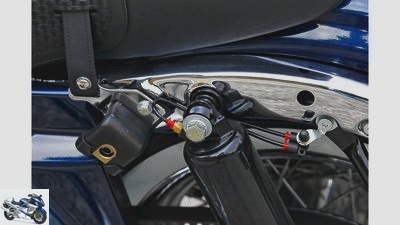
37/50
Harley-Davidson Road King Classic
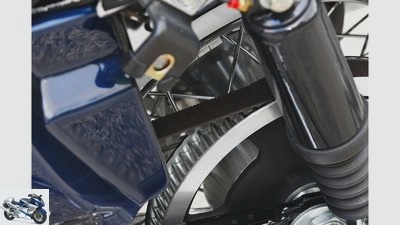
38/50
Harley-Davidson Road King Classic
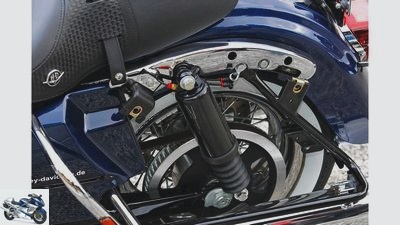
39/50
Harley-Davidson Road King Classic
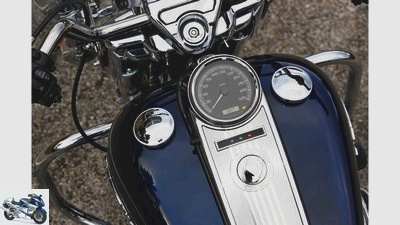
40/50
Harley-Davidson Road King Classic
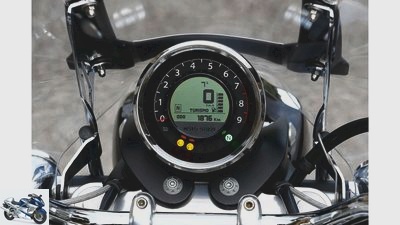
41/50
Moto Guzzi California 1400 Touring
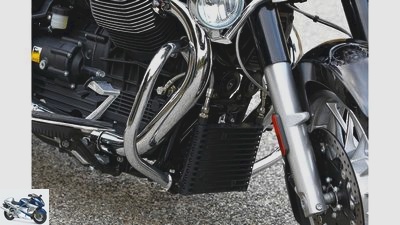
42/50
Moto Guzzi California 1400 Touring
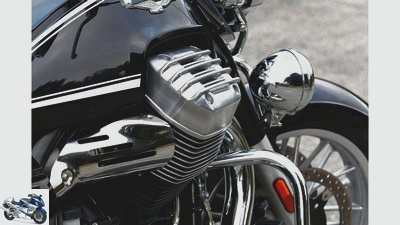
43/50
Moto Guzzi California 1400 Touring
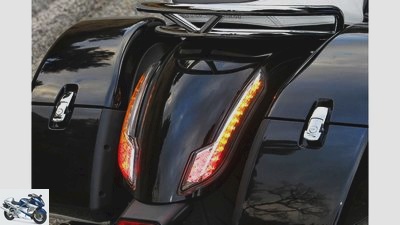
44/50
Moto Guzzi California 1400 Touring
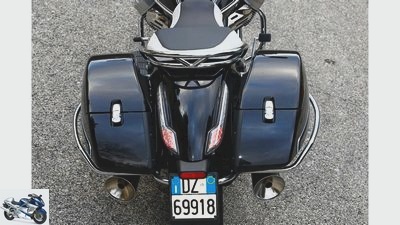
45/50
Moto Guzzi California 1400 Touring
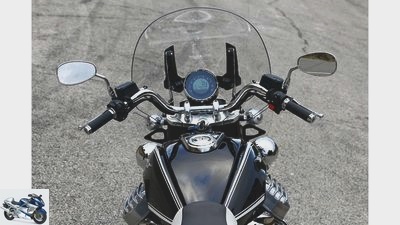
46/50
Moto Guzzi California 1400 Touring
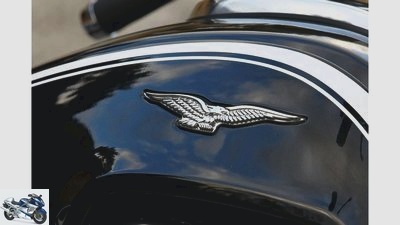
47/50
Moto Guzzi California 1400 Touring
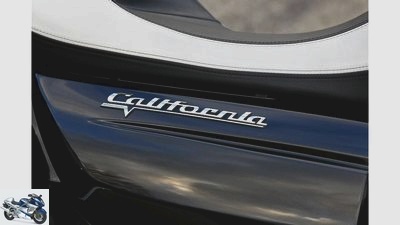
48/50
Moto Guzzi California 1400 Touring
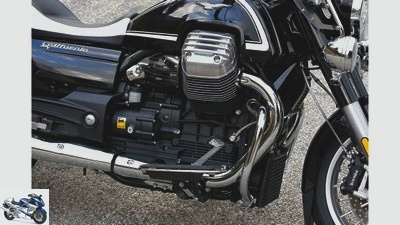
49/50
Moto Guzzi California 1400 Touring
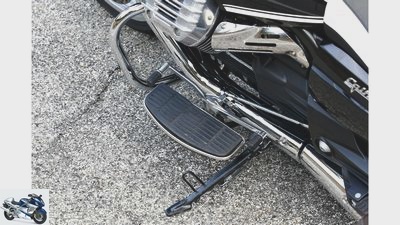
50/50
Moto Guzzi California 1400 Touring
Comparison test touring cruiser, Harley-Davidson Road King Classic, Moto Guzzi California 1400 Touring
Harley-Davidson Road King Classic versus Moto Guzzi California 1400 Touring
Striking and powerful, big and heavy: this duo combines classic cruiser character with touring virtues of two traditional manufacturers. The Moto Guzzi 1400 California Touring aims directly and dignified at the US bike Harley-Davidson Road King Classic.
TA ton of people and machines come rolling through the city, roaring and pounding, spread over two motorbikes and their drivers. Badumm, badumm, badumm. It’s a twin-twin situation, a test constellation from a motorcycle picture book. Mighty machines, built around large, characteristic V2 engines, casually fall on their side stands. Coffe break. Heads turn, necks stretch. The passers-by are obviously having fun. The freshly parked engines with almost 1.4 or even 1.7 liters of displacement crackle for hours. The Harley cracks nicer and longer. Can you construct that?
Buy complete article

Comparative test touring cruiser
Harley-Davidson Road King Classic versus Moto Guzzi California 1400 Touring
Moto Guzzi California 1400 Touring two of the most illustrious names in motorcycle history. The similarities between the US bike and the brand new challenger from this side of the Atlantic are impressive. Both luxury cruisers have air-cooled V2 engines with easy-care final drives. Okay, in Mandello del Lario you only use a single-motor 90-degree cylinder angle, installed lengthways. In Milwaukee, on the other hand, the transversely installed engine with cylinders spread by 45 degrees to form the Victory symbol has been a trademark since 1909.
Across all philosophies and questions of faith, the drives here and there are “vibrationally elastic" hung in classic steel double loop frames. The surroundings of both are opulent: large windows, two additional headlights each, thickly veneered forks and fat crash bar sets exude a feeling of invulnerability even when the vehicle is stationary. Lush weight of seven hundred pounds and exhaust systems laid on both sides with furnace pipe-length silencers cite traditional mechanical engineering. Thick driver saddles and standard panniers (leather-covered on the Road King, in a hard shell version on the Cali) represent traditional touring virtues. Large double disc brakes at the front, with ABS as standard. The cruise control, also standard, is called “Cruise Control” here". How else?
(Not) a question of the V2 philosophy: Both luxury cruisers convey a lot of driving pleasure.
After a good 40 years of Cali history, the new California is taking a new path: Its predecessors, especially in the 70s and 80s, were agile, not too heavy touring motorcycles that became more and more cruising over the years. Past. The 1400 is a 345 kilogram luxury cruiser. It is clearly aimed at the US market and pays homage to its predecessors, following on from the styling of the Calis with 750, 850 or 1000/1100 cubic meters. For example the classic black and white color scheme and the lush bench with white edges. Moto Guzzi calls this combination “Nero Ambassador”.
It became one hell of a motorcycle. Probably Guzzi designer Miguel Galluzzi, a 1.95 meter man, after his compact creations like Ducati’s monsters, Cagiva Planet or the Aprilia RSV4 finally designed a motorcycle that he himself fits really well. From every perspective, the 1400 looks more massive than the not exactly small Road King: longer, wider, higher. The extremely flat fork (58 degrees steering head angle) and the consistently logical drive train of the lengthways crankshaft with the subsequent cascade of clutch, gearbox and cardan stretch the wheelbase to a record-breaking 1.68 meters.
The Harley has six centimeters less between the wheel axles. The whole motorcycle is shorter, narrower, looks more compact in comparison. An optical illusion? After all, the street king weighs an immense 373 kilograms. There are only a handful of even heavier motorcycles. Something like this is a real quality criterion in cruiser circles.
Right? The Harley is particularly stable and of high quality. They could be carried away by the indicators. Their sparkling chrome seems to be applied thicker – and that by the square meter. There are also more handy, more massive switches. And their fenders, unlike those of the Guzzi, deserve their name, because they are made of sheet steel instead of plain plastic.
The touring cruisers from Harley-Davidson and Moto Guzzi sit well.
It is a lot of little things that define style, but style is anything but a small thing. The Road King is Harley’s only tourer without the Bat Wing fairing, which has been installed since 1969. It is a monumental motorcycle, at first glance it still looks like US police machines in the time of John F. Kennedy 50 years ago. Well, their predecessors, like the earlier California series, which were also police service, actually escorted kings and presidents.
Willie G. Davidson was personally responsible for design at Harley-Davidson from 1963 to 2012. He knew how to do it. Form follows emotion. If Harley were to build trains instead of motorcycles, they would develop an American Intercity that would look like a Western Union Express.
A lot of driving pleasure with both cruisers
The duo perfectly combines classic cruiser character with touring virtues.
The Road King is a rolling creed. You don’t have to explain anything with it. Every viewer knows intuitively. Wow, tubeless whitewall tires on shiny spoke wheels – a new rubber seal on the rim base has made this possible since 2012. In order to have these Statue of Liberty on wheels all to yourself, the first thing to do is to overcome their self-activating alarm systems and immobilizers. With the Harley, you have to open the wonderfully antiquated ignition lock on the tank console. Then remove the key, the on-board electronics recognize the separate transmitter on the lanyard.
Not so with the Guzzi. Before each departure, you have to press the little button on the transmitter. The starters bring the two Big Twins up to speed in a really ceremonial way. The large cylinders of the California measure 1380 cm3. Mighty 104 pistons whiz up and down in it – 81.2 millimeters to be precise. This is the largest Guzzi engine ever. Its high, polished caps above the valve covers are striking. They crown the engine with their ingenious slots. It is the largest V2 ever made in Europe. But not the largest two-cylinder in Europe – the Triumph Thunderbird piles up even more with up to 1.7 liters.
When standing, the 90-degree V2 prottelt and pulsates great, just like all Guzzis before her with fine V2 staccato. The soul massage begins. This is matched by the typical reverse torque of the crankshaft rotating transversely to the direction of travel: the Guzzi responds to every throttle bump while idling with a very slight turn: first to the right and then back to the vertical starting position.
The opening and closing of the central throttle valve (see technical box below) is not noticeable. Such ride-by-wire, an Aprilia legacy, is still new at Moto Guzzi. Has the Harley since 2007. Plus other electronic gadgets. A corresponding flap system in the oval, baseball-like air filter and the right of the two silencers, for example. Tribute to applicable noise limits. The flaps remain closed in the measurement-relevant area. Don’t worry, the soundscape is full with this trick, but never intrusive. The rumble of this bubbling motor comes across simply more relaxed at every speed, in every load range. The potato-potato-potato penetrates the driver in a subdued but absolutely calming manner. Simply smooth, this long-stroke V2 with external bumper covers and a powerful 111.1 millimeter stroke. The US icon measures a full 103 cubic inches. Makes 1690 cm3 in the metric system. That would be enough for a car.
You believe you can feel every cycle, every single crankshaft rotation. It goes well with how the towering 45-degree V2 bounces back and forth in the frame. It is intentional, the vibration isolating engine suspension makes it possible. The Guzzi V-Twin also has one. With the same goal: good vibrations when standing, no disruptive vibrations while driving. Works incredibly well at Cali. Nothing stomps there. The engine runs super smoothly. He also takes the gas gently in touring mode, the middle of the three mappings. From 1500 rpm the Guzzi gets going and runs really smoothly, even in sixth gear. Up to 2500 tours is the absolute feel-good area. Above this, the mechanical noises from the engine and from the drive suddenly dominate.
You can hear the transmission howling (especially in third gear), little from the exhaust. If the Harley can’t pass, it retains its cozy thump even under load. Especially since your toothed belt runs quietly – and with even less disruptive load change reactions when gas is open and closed. The US bike serves its strength as silky soft and yet robust. 300 cubic more, you can feel it. The experience value when driving is simply higher. Although the Road King never converts its beefier torque into better performance. The engine’s welcome braking torque is greater, the manual clutch force required is greater and the shift feel richer: every gear engages with a pithy click after a significantly longer shift path than on the Guzzi. However, the operation of the US rocker switch turned out to be less ergonomic, the heel has to dance more than on the Italian.
The Guzzi accelerates much faster. It even pulls worlds faster in sixth gear – the low-torque Harley has a gear ratio that is far too long compared to its Vmax. But whatever? It’s exactly about such low speeds. With the exact speed, the Road King keeps up with the performance like Rolls-Royce: enough. Only Cali has a tachometer. Plus a highly informative on-board computer. And a traction control that is beneficial on slippery surfaces because it is sensitive to it. That’s a good thing, because when it rains, the feedback that has been good up to then is completely lost. In wet conditions, the Harley’s Dunlop tires work better than those of the Guzzi.
The handlebars of the Italo bike are more relaxed
Showdown under the Statue of Liberty. No, not in New York, but in Saint-Cyr-sur-Mer in the south of France.
The Cali wears wide tires. A 130 18-inch roller rotates at the front, a fat 200 16-inch roller at the rear. Cast rims with many filigree spokes, between which – unlike the Harley – cranked valves are conveniently located. In dry conditions, in curves and on uneven surfaces, the Guzzi chassis works much better than its US counterpart. When switching directly, the Cali looks more manageable, light-footed. Like a different class of motorcycle. This is where the motor’s installation position works because it reduces the gyroscopic forces. One-to-one implements the Guzzi steering commands and folds down exactly as required.
The Cali always stays stable and on track. Class! In addition, there is a high level of neutrality in an inclined position. And that although the hard plastic sanding blocks under the running boards touch down quite early, before solid metal hits the collar. Even rough bumps don’t irritate the Italian. Your suspension elements respond well, especially the fork with mighty 46 mm stanchions. On streets, mind you, where the Harley starts wobbling early. When cornering, it requires constant counter-pressure on the handlebars, which are quite far away. Little Harley riders ride with their arms fully extended. And the US seat requires longer legs.
The oncoming handlebars of the Italo bike are more casual at hand. Its deeper seat is no less comfortable. Both here and there there is good lumbar support. A lush cushion for a passenger, however, only on the Guzzi. At Harley you first have to go through the accessories catalog, traditionally thicker than the Cologne telephone directory. Does it also offer finer spring elements? The air-assisted US struts, which were all the rage in the 80s, offer less reserves with only 76 millimeters of spring travel. It’s a shame, because that way you can never fully use the full 244 kilograms of payload, 42 more than with the Cali.
In contrast to that of the Electra Glide, the slender 41 fork of the Road King does not have an elaborate cartridge damper system. You can tell. In the form of a rather clumsy response. When the brake is used, the front bends strangely, especially when it is inclined. The simple American brakes combine high manual force with moderate effect and controllability. After all, when you step on the automobile-like large pedal, there is good, sometimes too strong, support from the rear. The ABS control processes fail with a clattering clatter. Like at BMW 20 years ago.
The 3,000 euros cheaper Guzzi once again demonstrates how it can be done better. Four-piston Brembo stoppers attached radially to the conventional fork allow the travel giant to be carefully braked. And when in doubt, you hardly notice the ABS’s sensitive intervention. Fine. Objectively speaking, there is a lot in favor of the Cali. That it consumes less, albeit not less, petrol – 6.0 instead of 6.5 liters in roll mode on the country road. That their hand levers are adjustable and their lighting technology with LEDs at the front and rear (daytime running lights!) Is more modern. Important for frequent riders instead of strolling: that it only has to be serviced every 10,000 kilometers, the Harley a little earlier, after 8,000. After all, its valve clearance is maintenance-free, spark plugs only need to be changed every 48,000 kilometers.
To this day, a 2007 Road King, still with a Twin Cam 96, tops the list of the best of MOTORRAD’s endurance test machines. Immense resale value and low susceptibility to defects make it possible. So then: Showdown under the Statue of Liberty. No, not in New York, but in Saint-Cyr-sur-Mer in the south of France. The more authentic road cruiser with a more pleasant boom is the more traditional-looking Harley. The beat of the almost 1.7 liter long stroke is simply more casual. King of the Road the Road King? Technically, the California 1400 is king of the road: clearly the better, noticeably more modern motorcycle in almost every respect. It drives functionally inspiring and celebrates its own style. For lasting values.
Data and measured values Moto Guzzi
Classically inspired and yet modern: white seat bench with chrome rails and elongated exhausts meet 200 mm rear tires plus radially operated four-piston brakes.
engine
Design: two-cylinder four-stroke 90-degree V-engine
Injection: Ø 52 mm
Clutch: single-plate dry clutch
Bore x stroke: 104.0 x 81.2 mm
Displacement: 1380 cm3
Compression: 10.5: 1
Output: 71.0 kW (97 hp) at 6500 rpm
Torque: 120 Nm at 2750 rpm
landing gear
Frame: double loop frame made of steel
Fork: telescopic fork, Ø 46 mm
Brakes front / rear: Ø 320/282 mm
Assistance systems: ABS
Wheels: 3.50 x 18; 6.00 x 16
Tires: 130/70 R 18;
200/60 R 16
Tires: Dunlop D 251
Dimensions + weights
Wheelbase: 1685 mm
Steering head angle: 58.0 degrees
Trail: 155 mm
Suspension travel front / rear: 120/110 mm
Seat height **: 750 mm
Weight with a full tank **: 345 kg
Payload **: 202 kg
Tank capacity / reserve: 20.5 / 5.0 liters
Service intervals: 10000 km
Price: 19600 Euro including utilities
Price test motorcycle: 19600 euros incl
Additional costs: –
Moto Guzzi California 1400 Touring: New cardan without torque support, stereo struts.
MOTORCYCLE readings
Top speed *: 185 km / h
Acceleration:
0-100 km / h: 5.5 sec
0–140 km / h: 9.8 seconds
Draft:
60–100 km / h: 4.9 sec
100–140 km / h: 6.9 seconds
Consumption on country road: 6.0 liters
Range of the highway: 342 km
* Manufacturer information; ** MOTORCYCLE measurements; *** including two-tone paintwork
Harley-Davidson data and measurements
The shapes and harmonious proportions of the Harley-Davidson, which have been familiar for decades, are self-explanatory. Chic: Spoked wheels with whitewall tires
engine
Design: two-cylinder four-stroke 45 degree V engine
Injection: Ø 46 mm
Clutch: multiple discs-
Oil bath clutch
Bore x stroke: 98.4 x 111.1 mm
Displacement: 1690 cm3
Compression: 9.6: 1
Output: 62.0 kW (84 PS)
at 5010 rpm
Torque: 134 Nm at 3500 rpm
landing gear
Frame: double loop frame made of steel
Fork: telescopic fork, Ø 41 mm
Brakes front / rear: Ø 300/300 mm
Assistance systems: ABS
Wheels: 3.00 x 16; 5.00 x 16
Tires: 130/90 B 16;
180/65 B 16
Tires: Dunlop, front D 408, rear D 407
A clean affair: the timing belt that is unfortunately only typical of Harley-Davidson.
Dimensions + weights
Wheelbase: 1625 mm
Steering head angle: 64.0 degrees
Trail: 170 mm
Suspension travel front / rear: 117/76 mm
Seat height **: 740 mm
Weight with a full tank **: 373 kg
Payload **: 244 kg
Tank capacity / reserve: 22.7 / 3.8 liters
Service intervals: 8000 km
Price: 22295 euros
Price test motorcycle: 22,995 euros ***
Additional costs: 490 euros
MOTORCYCLE readings
Top speed *: 180 km / h
Acceleration:
0-100 km / h: 5.8 sec
0–140 km / h: 11.6 sec
Draft:
60–100 km / h: 7.5 sec
100–140 km / h: 10.2 seconds
Consumption country road: 6.5 liters
Range of the highway: 349 km
* Manufacturer information; ** MOTORCYCLE measurements; *** including two-tone paintwork
The technology of the bolides
Manufacturer
This Guzzi-V2 is no longer load-bearing, but elastic in rubber elements (red).
Moto Guzzi is breaking new ground with the California 1400. The engine is based on previous four-valve engines – so it inherited their engine housing and shares a stroke of 81.2 millimeters with all 1200s (Stelvio, Griso, Norge, Sport). But around it, almost everything is new in the largest engine in Guzzi history. A full 104 millimeter bore is nine more than before. In order to reduce the flame paths, two spark plugs per cylinder ensure efficient combustion of the mixture. As with the V7 models from 2012, this provides a central throttle valve, here 52 millimeters in size, under the driver’s seat.
From there, two long intake paths with an expansion chamber lead to the combustion chambers. A single throttle saves potential synchronization problems. For the first time at Moto Guzzi, it is not operated by a Bowden cable but by a servomotor from the on-board electronics. This ride-by-wire allows different maps (mappings) for ignition and injection: The strength and spontaneity of the throttle commands can be varied in three stages – even while driving. The traction control, which can be switched off, also works in three stages. In addition, the central throttle valve simplifies the regulation of the cruise control. The valve train of the Guzzi-V2 is controlled by a chain-driven, elevated camshaft per cylinder, rocker arm and short tappets.
Manufacturer
Two underlying camshafts control two valves per cylinder via bumpers, rocker arms and hydraulic valve lifters.
The large oil cooler with an electric fan, which is located deep in front of the engine, regulates the thermal balance. The six-speed gearbox (all Californias previously had five gears) and the right-hand rotating cardan with a large angular drive are newly designed. The final drive comes from the long aluminum U-swing arm without torque support. The hydraulically operated single-plate dry clutch is located between the motor housing and the flanged gearbox. The Cali suspension is also completely new. For the first time in the history of the Guzzi V-Twins, the engine is no longer bolted directly to the frame. An elasto-kinematic suspension in rubber elements dampens the vibrations of the large motor. The Harley-V2 is also suspended elastically in a steel frame.
It also has an oil cooler, ride-by-wire and cruise control. But that’s where the similarities end. In contrast to the Guzzi, it is long-stroke, transversely installed and has 45 instead of 90 degree cylinder angles. Here the 98.4 millimeter pistons whiz back and forth a full 111.1 mm between the dead centers. Two lower camshafts driven by a toothed chain, hence the name Twin Cam, drive only two valves per cylinder via four long bumpers, rocker arms and maintenance-free hydraulic valve lifters. The primary drive is provided by a duplex chain, the frictional connection to the toothed belt is provided by a mechanically operated multi-disc oil bath clutch. While Moto Guzzi relies on wet sump lubrication, the Harley bunkers its engine oil in the dry sump lubrication reservoir.
MOTORCYCLE conclusion
BILLION
The performance measurement of the Harley-Davidson and the Moto Guzzi,
The long-stroke Harley-V2 lifts a beefy picture-perfect torque curve. A real saddle of a buffalo with always more than 100 Newton meters from 1750 rpm to 5500 tours. Great, even if 79 hp, five less than promised, is little with just under 1.7 liters of displacement. A maximum of 113 Newton meters of the Guzzi is not a particularly good yield at 1390 cm³. The torque curve has two maxima: at 2750 and 5500 tours. In between there is a slight depression that is imperceptible when driving. The Italo-V2 was unusually easy to turn with 96 thoroughbred horses over 7000 rpm.
Conclusion Harley-Davidson Road King Classic
Okay, the chassis and brakes could use fine-tuning. The king of the street is better at representing than at governing. But that’s perfect. And the feeling when driving is inimitable. The V2 beat comes across as even more casual. The experience value is simply higher. A real men’s motorcycle, but one for aesthetes.
Conclusion Moto Guzzi California 1400 Touring
Bulky and important: the new Cali is a real alternative to the Harley! Because it’s the better touring bike and the more modern motorcycle. Lighter, bigger, cheaper and equipped with more features. In addition, there is more power, safer brakes and the much better chassis. Only in terms of sound and feeling does the Italo-V2 easily lose out.
Related articles
-
Impression: Harley-Davidson Road King Classic and Moto Guzzi California Vintage
Artistic Impression: Harley-Davidson Road King Classic and Moto Guzzi California Vintage There’s only two directions here, boy! With two air-cooled …
-
Impression – Moto Guzzi California Touring, Indian Springfield and Harley-Davidson Road King Classic
bilski-fotografie.de Impression – Moto Guzzi California Touring, Indian Springfield and Harley-Davidson Road King Classic Westwards Two days free: …
-
Harley-Davidson Road King Classic old versus new tested
www.bilski-fotografie.de 15th photos bilski-fotografie.de 1/15 Picture gallery: Harley-Davidson Road King Classic old / new. bilski-fotografie.de 2/15…
-
Gargolov 50 pictures Gargolov 1/50 The Yamaha XV 1900 A Midnight Star is the only one to brake without ABS, but with a composite system. Gargolov 2/50 Sometimes …
-
Harley-Davidson Fat Boy S and Moto Guzzi California Custom put to the test
markus-jahn.com 22nd photos markus-jahn.com 1/22 I’m a Celebrity, Get Me Out of Here? Oh no. Harley-Davidson Fat Boy S and Moto Guzzi California Custom…
-
35 pictures 1/35 picture gallery: Triumph Bonneville T100 Black, Moto Guzzi V9 Roamer and Harley-Davidson Sportster 883 Iron in …
-
Test Moto Guzzi California 1400 Touring
Manufacturer test: Moto Guzzi California 1400 Touring Italian touring cruiser When the leaves were brown and the sky was gray, The Mamas dreamed of …
-
Moto Guzzi California old versus new
fact 39 pictures fact 1/39 generation meeting at Guzzis. The Moto Guzzi California 1400 from 2013 compared to its ancestor, the 850 T3 from …
-
Comparison test Harley-Davidson Road King Classic against Yamaha XV 1600 Wildstar
Comparison test Harley-Davidson Road King Classic against Yamaha XV 1600 Wildstar IG Metall Hard times for Harley-Davidson. In Heayv’s tariff poker …
-
Driving report Moto Guzzi California 1400 Custom
Manufacturer 39 photos fact 1/39 Generation meeting at Guzzis. The Moto Guzzi California 1400 from 2013 in comparison with its ancestor, the 850 T3 from…